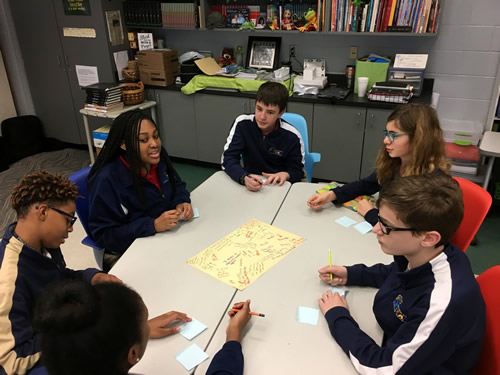There is a fair amount of research into the impact of classroom design on student learning. Spaces flooded with natural light that allow for a variety of learning methods and activities, and spaces that let students feel a sense of ownership over the classroom, demonstrably affect how well students learn.
Active learning applies a similar principle, including minimizing institutional barriers like teacher lecterns, fixed and stagnant furniture, and limited student exposure to real-world experiences. Through active learning, the teacher gradually releases control to the students, encouraging them to become independent learners.
Four years ago, I became an inaugural recipient of a Steelcase Education Active Learning Center Grant. The renovated classroom and colorful mobile chairs and desks provided by the grant have literally transformed my practice, my seventh-grade language arts students, and their families. Test scores, homework completion, and grades have soared and parents who had never visited their student’s classroom now volunteer regularly. My research in our active learning classroom (ALC) over the past three years led me to discover seven elements critical to student success.
1. Reflective practice is critical for continued growth.
In our ALC, continuous reflection is critical and expected of both teacher and students, and requires a laser focus on planning, implementation, and assessment. I have learned to look at multiple perspectives in any given situation and I model that practice for my students. We continually revisit our work, looking for connections to prior projects and lessons, hoping to improve the overall learning experience and its application to real-life situations. Through research, students make inferences and draw conclusions but are encouraged to look beyond the obvious from multiple perspectives focusing not only on what is known but what is possible. Failure is recognized, encouraged, and embraced as essential to learning as we all strive for personal improvement, academic tenacity, and success.
2. Social-emotional learning is a huge part of our learning process.
The increase in student absenteeism, bullying behaviors, disinterest in school, and violence has sparked the need for social-emotional learning in the classroom. Students enter my classroom with a plethora of emotional concerns that interfere with learning. Active learning environments provide a unique level of comfort for students, evident in my classroom. Our no-judgment zone encourages risk taking and failure becomes a catalyst for revision and improved design. Students feel free to move, communicate, and collaborate. Learning is a community experience.
3. Parent and community involvement make learning meaningful and increase student success.
There is an obvious need for parent and community involvement in the classroom and the student learning experience. Although the desire is often there, an open invitation and feeling of inclusion is not. The intentional inclusion of the community in our ALC through health fair and entrepreneur studies has provided an authentic perspective to my students’ educational experience. By bringing the community into the classroom and involving parents in their child’s education, student growth and success becomes multi-faceted.
4. Relevant content cannot be compromised due to an evolving global market.
There are multiple educational and career avenues from which students may choose and career opportunities still to be created. Students today want education to be relevant to their world and meaningful to their future. At the same time, they want opportunities to study topics that interest them. Through personalized learning, students design, plan, and implement experiences steeped in rich content based on their personal interests. The challenge for the ALC teacher is to assure that the educational experience is standards-based and skill development is evident and measurable.
5. Data collection must be a priority.
Data provides credibility to and legitimizes our practice. It forces us to focus on the skills our students need to master for academic success and provides a basis for critical conversations about student growth, classroom practices, and the impact of innovative strategies. In addition, data provides the confidence to implement innovative practices.
Since the ALC was installed, student success been on the rise:
- Completed assignments increased from 52 percent to 98 percent
- End-of-year grades increased for 95 percent of students, up from 81 percent the previous year
- Growth targets for reading almost doubled, from 35 to 62 percent
6. The aesthetics of the classroom facilitate learning.
The ALC is an environment in which students want to spend time. Bright primary colors and bright lighting, including natural light, encourage and facilitate the learning process. Students are more motivated by a learning environment they control and the furniture with wheels allows them to take ownership of their learning space, and they can quickly organize themselves into large and small groups as necessary.
7. We need more ALCs
Active learning reintroduced excitement, passion, and a desire for learning to my classroom. In the ever-changing educational landscape, students need spaces where they can brainstorm issues, postulate solutions, research validity, analyze and test theses, and apply their ideas in an environment that supports and encourages change. I have observed students enter and make the transition to the active learning environment, witnessing the pride they feel as they grow and learn skills needed for success. I have also entertained their questions and concerns as they are forced to return to traditional classrooms. To better address the needs of our 21st-century learners and prepare them for future success, our schools need to provide more ALCs.
[Editor’s note: To learn more about how to apply for a 2019 Steelcase Education ALC Grant, click here. The deadline for applications is Feb. 1. Each grant includes furniture, design review, installation, onsite training, and a Learning Environment Evaluation measurement tool.]
- 4 ways to encourage play in education - April 25, 2024
- CoSN IT Leader Spotlight: Lisa Higgins - April 25, 2024
- It’s time to pay student teachers - April 25, 2024

